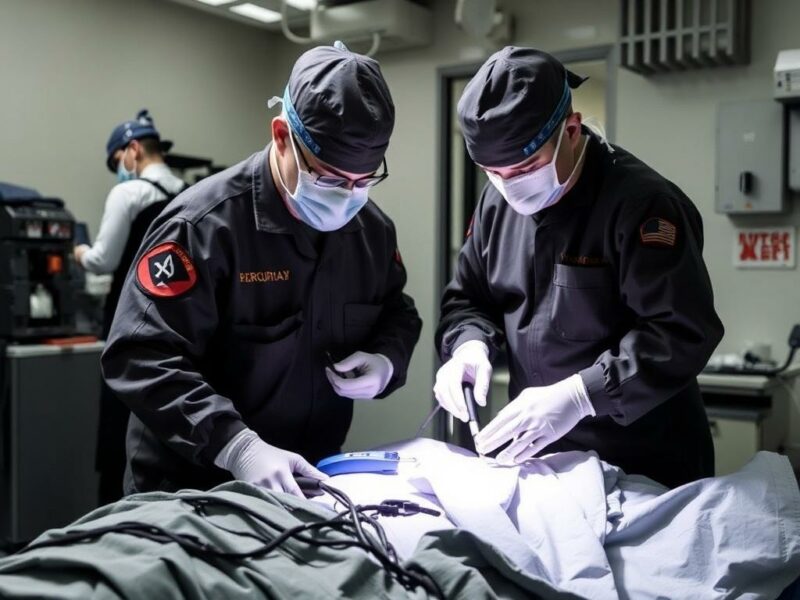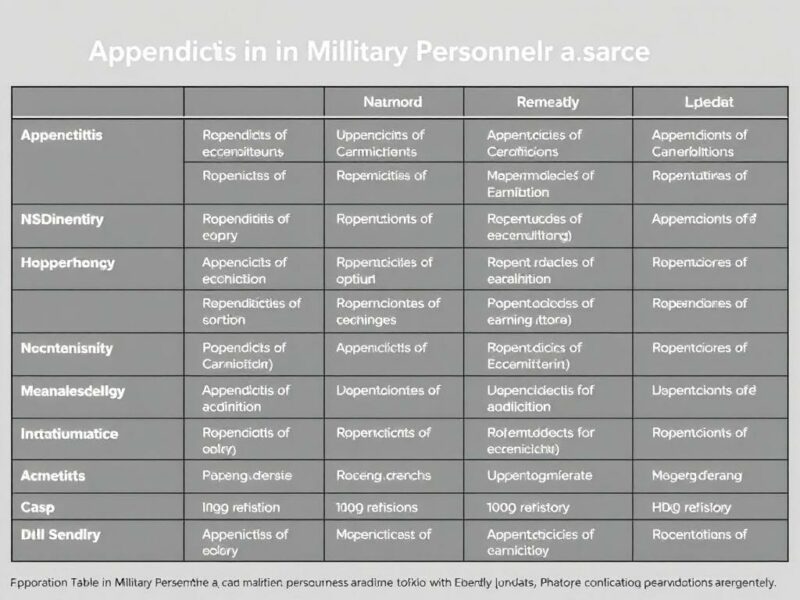Appendicitis is a common medical emergency that affects millions worldwide, but for military personnel, the implications can be even more complex and urgent. The nature of military service—with its physical demands, unpredictable environments, and limited access to immediate medical care—makes appendicitis a particularly significant health concern. In this article, we will explore the causes, symptoms, diagnosis, and treatment of appendicitis among military personnel, along with the unique challenges faced by service members experiencing this condition.
What Is Appendicitis and Why Does It Matter for the Military?
Appendicitis is the inflammation of the appendix, a small, tube-shaped organ attached to the large intestine. Although the appendix doesn’t perform a critical function, its sudden inflammation can quickly escalate to a medical emergency if untreated. In civilians, appendicitis typically leads to swift diagnosis and surgery. However, military personnel may face difficulties due to deployment locations, physical exertion, and the necessity to maintain operational readiness.
For military members, appendicitis is not just a health issue—it can impact unit effectiveness, morale, and mission success. Because military personnel often operate in remote or austere environments with limited access to advanced medical facilities, prompt recognition and diagnosis of appendicitis are critical.
Causes and Risk Factors of Appendicitis in Military Personnel
While the exact cause of appendicitis remains unclear, it generally results from blockage of the appendix’s interior. This blockage may be due to fecal matter, lymphatic tissue swelling, infections, or even trauma. In the military context, several factors can contribute uniquely to the risk of developing appendicitis:
- Physical strain and exertion: High-intensity training and strenuous physical activity may exacerbate abdominal conditions or increase vulnerability to appendiceal irritation.
- Infections and gastrointestinal disturbances: Military personnel are often exposed to diverse environments and food sources, increasing the risk of infections that may trigger inflammatory responses.
- Stress and immune response: Prolonged physical and psychological stress can alter immune function, potentially affecting susceptibility to inflammation.
Despite these factors, it is important to emphasize that appendicitis can strike anyone at any time, independent of profession. Yet, the occupational demands on military members may amplify the risks or consequences.
Table: Common Causes and Contributing Factors of Appendicitis
| Cause | Description | Military Connection |
|---|---|---|
| Blockage by fecalith | Hardened stool obstructs the appendix | Rapid dehydration and dietary changes can promote blockages |
| Lymphoid hyperplasia | Swelling of lymphatic tissues due to infection | Frequent exposure to infections during deployment |
| Trauma | Abdominal injury causing inflammation | Physical combat or training injuries |
| Gastrointestinal infections | Bacterial or viral infections causing inflammation | Unfamiliar water or food hygiene conditions |
Clinical Presentation: Recognizing Appendicitis in Active Duty Service Members
Prompt recognition of appendicitis symptoms can be life-saving, especially in the military where delays in treatment can lead to severe complications. The classic symptoms of appendicitis include:
- Sudden onset abdominal pain, often starting near the navel and shifting to the lower right side
- Nausea and vomiting
- Loss of appetite
- Fever and chills
- Abdominal tenderness and guarding
- Constipation or diarrhea
Military personnel may sometimes dismiss these symptoms as routine transient abdominal discomfort or stress-related issues, risking delay. It’s vital that service members, medics, and commanders recognize the seriousness of these symptoms and seek immediate medical evaluation.
Impact of Delayed Diagnosis in Military Settings
Delay in identifying appendicitis can lead to rupture of the appendix, peritonitis, abscess formation, and systemic infection—conditions that complicate treatment and prolong recovery. For military personnel, this may mean evacuation from combat, prolonged hospitalization, and extended absence from duty. In austere or combat environments, lack of advanced diagnostic tools makes clinical suspicion and early intervention even more critical.
Diagnosing Appendicitis in Military Environments

Diagnosis of appendicitis traditionally involves a combination of physical examination, laboratory tests, and imaging studies. However, the availability of these diagnostic tools in deployed military settings can vary:
Physical Examination
Military medics and providers rely heavily on clinical signs such as localized tenderness at McBurney’s point, rebound tenderness, and elevated white blood cell counts to suspect appendicitis.
Laboratory Tests
Basic labs like complete blood count (CBC) may show elevated neutrophils indicating infection. In the field, laboratory availability may be limited, so clinical judgment remains paramount.
Imaging Studies
- Ultrasound: A non-invasive test often accessible in field hospitals, useful to detect inflamed appendix or abscesses.
- CT Scan: The gold standard for appendicitis diagnosis but less likely available near front lines or in remote deployment areas.
Military healthcare systems strive to equip forward medical teams with portable ultrasound machines and telemedicine support, enabling earlier diagnosis and decisions regarding evacuation.
Treatment Approaches: Navigating Appendicitis Care in the Military
Once appendicitis is diagnosed, surgery—typically an appendectomy—is the definitive treatment. In military medicine, the approach depends on the operational setting:
Appendectomy Types
- Laparoscopic Appendectomy: Minimally invasive, preferred for rapid recovery and minimal wound complications. Used in well-equipped military hospitals.
- Open Appendectomy: Traditional open surgery, sometimes necessary in complicated cases or where laparoscopic equipment is unavailable.
Non-Surgical Management
There is ongoing debate over treating uncomplicated appendicitis with antibiotics alone. Some military protocols may temporarily employ antibiotic treatment where surgical options are delayed. However, surgery remains the standard to prevent rupture.
Challenges Specific to Military Personnel
- Deployment constraints: Evacuating a service member for surgery may affect mission readiness and unit dynamics.
- Postoperative care: Recovery requires rest and limited physical activity, difficult in combat zones.
- Rehabilitation and Return to Duty: Military doctors carefully assess fitness to return after surgery, balancing healing with operational needs.
Table: Treatment Modalities and Considerations for Military Appendicitis
| Treatment | Advantages | Challenges in Military Context |
|---|---|---|
| Laparoscopic Appendectomy | Quicker recovery, less pain, shorter hospital stay | Requires specialized equipment, not always available near combat zones |
| Open Appendectomy | More accessible, effective for complicated cases | Longer recovery, more pain, risk of wound complications |
| Antibiotic Therapy | Non-invasive, can be used as a bridge to surgery | Risk of recurrence, not a definitive cure, requires careful monitoring |
Prevention and Preparedness: Minimizing Appendicitis Impact in Military Units
While preventing appendicitis altogether may not be feasible, military command and healthcare providers can take steps to reduce risk and improve outcomes:
- Education: Training military personnel to recognize early symptoms of appendicitis to encourage prompt medical consultation.
- Medical readiness: Ensuring field medics and remote providers have training and tools (like ultrasound) for early diagnosis.
- Hygiene and diet management: Maintaining clean food and water supplies to reduce gastrointestinal infections contributing to appendiceal inflammation.
- Rapid evacuation protocols: Establishing clear procedures for evacuating suspected appendicitis cases to higher care facilities without delay.
Case Studies: Real-Life Examples of Appendicitis in Military Contexts
Consider the scenario of a deployed infantry unit in a remote region. A soldier develops abdominal pain after several days of intense training and field operations. The unit medic, trained to suspect appendicitis, performs a portable ultrasound confirming inflammation. The soldier is promptly evacuated to a forward surgical team where a laparoscopic appendectomy is performed within hours. Following a monitored recovery, the soldier returns to duty within weeks. This example highlights how awareness, training, and equipment can save lives and preserve operational effectiveness.
In contrast, imagine a naval sailor experiencing vague abdominal discomfort who delays reporting symptoms. When the pain worsens, the appendix ruptures, leading to a complicated infection requiring extended treatment. The sailor must be removed from duty for months, impacting the ship’s manpower and maintenance tasks. These contrasting cases underscore the critical role of timely recognition and treatment in military appendicitis.
Psychological and Long-Term Implications for Military Personnel
Beyond physical recovery, appendicitis and its treatment may affect mental well-being. Anxiety about illness, surgery, and recovery can impact morale. Fear of being medically disqualified or separated from their unit may lead some personnel to underreport symptoms. Command structures must foster supportive environments encouraging early care without stigma.
Long-term, most military personnel recover fully from appendectomy with no complications. However, rare cases of chronic pain or postoperative adhesions can affect quality of life and service fitness. Periodic evaluations and rehabilitation services help address these issues comprehensively.
Future Perspectives: Innovations and Research in Military Appendicitis Care

The military medical community continuously seeks advancements to improve appendicitis care:
- Portable diagnostic devices: Development of compact ultrasound machines tailored for combat medics.
- Telemedicine: Remote consultations with surgeons to aid field diagnosis and management decisions.
- Minimally invasive surgical techniques: Expanding access to laparoscopic procedures near front lines.
- Antibiotic protocols and monitoring: Researching optimized non-surgical treatments to reduce surgery when appropriate.
These advances promise to reduce appendicitis morbidity in military settings, ensuring service members remain healthy and mission-ready.
Summary Table: Appendicitis in Military Personnel at a Glance

| Aspect | Key Points |
|---|---|
| Causes | Blockage, infection, physical strain, trauma |
| Symptoms | Abdominal pain, nausea, fever, tenderness |
| Diagnosis | Physical exam, labs, ultrasound, CT when available |
| Treatment | Appendectomy (laparoscopic/open), antibiotics in select cases |
| Challenges | Delayed recognition, limited resources, evacuation logistics |
| Prevention | Education, hygiene, readiness, rapid response |
Conclusion
Appendicitis in military personnel presents unique challenges that blend medical urgency with operational complexity. Understanding the causes, recognizing symptoms early, and initiating prompt treatment are crucial to preventing serious complications and preserving the health and readiness of service members. Military healthcare systems must continue to adapt by enhancing diagnostic capabilities, refining treatment protocols, and fostering a culture where early medical attention is encouraged and supported. For the brave individuals who serve, quick and effective management of appendicitis is more than just a health matter—it’s essential for continuing their mission to protect and serve.



